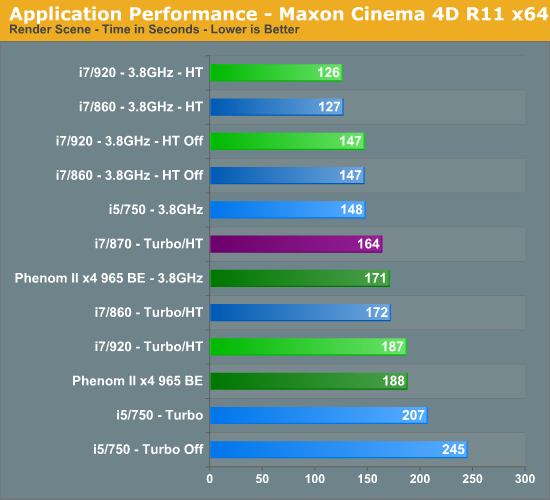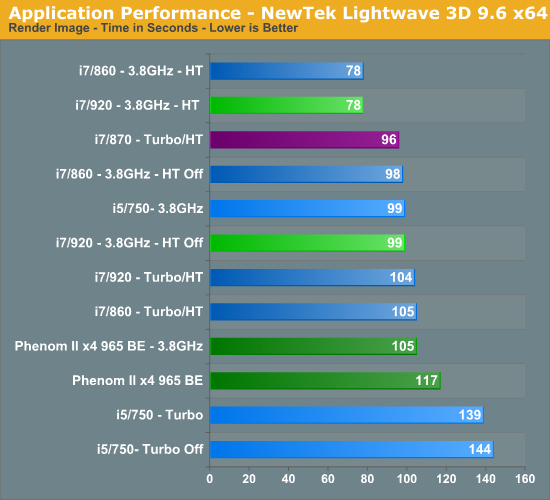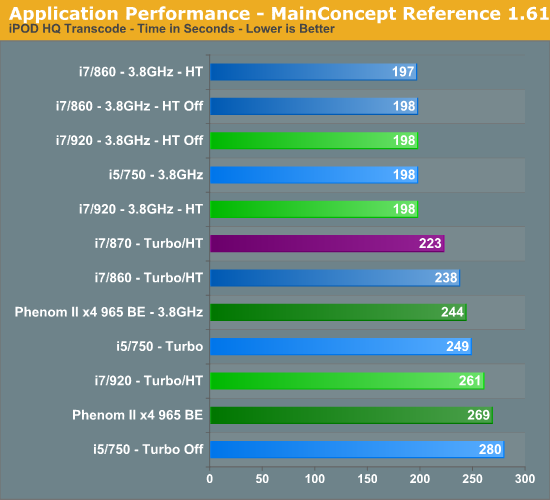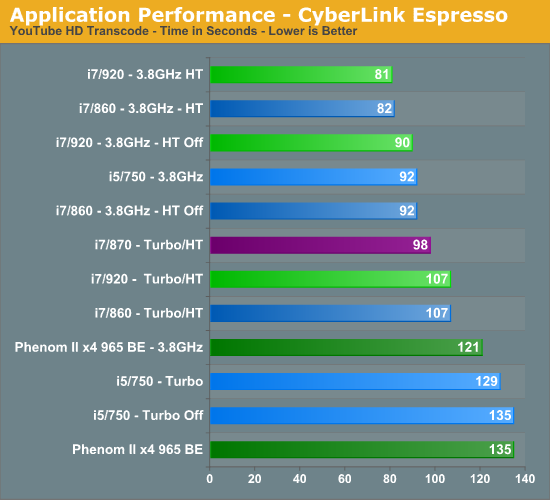i5 / P55 Lab Update - Now with more numbers
by Gary Key on September 15, 2009 12:05 AM EST- Posted in
- Motherboards
Applications-
Cinema 4D R11 x64
Cinema 4D R11 is one of our favorite programs to create high-end 3D images and animations. This particular program is sensitive to memory bandwidth and is well threaded. We track the time it takes to render a swimming pool layout.

Our i7/920 finishes first with the i7/860 just a second behind at 3.8GHz and with HT enabled. Disabling HT decreases performance 15% when these two CPUs are overclocked. The 965 BE is 27% slower at 3.8GHz than the i7/920 with HT enabled and 14% with HT disabled.
Turbo mode benefits the i5/750 greatly in this benchmark as turning it off results in the 750 being 16% slower. However, pure CPU speed allows the 965 BE to finish the benchmark about 10% quicker than the 750 with Turbo enabled and 23% with Turbo disabled with a 28% higher base clock speed. Of course, the 965 BE is 17% more expensive based on CPU cost comparisons.
LightWave 3D 9.6 x64
Another popular 3D rendering program is Lightwave 3D 9.6. In this test we time the rendering of a single frame from an office building animation. The time to render the full scene is approximately four and a half hours. This title is also well threaded and sensitive to both memory bandwidth and latency.

Lightwave also favors HT enabled processors with the 860/920 tying for first at 3.8GHz. Interestingly enough, Turbo mode on the i5/750 only offered a 3% improvement in this bench. The 965 BE scales very well as a 11% core speed increase nets a 10% improvement in the benchmark. However, the 965 BE still trails the 860/920 CPUs by 26% at 3.8GHz.
MainConcept Reference 1.61
One of our favorite video transcoding utilities is MainConcept Reference. We set our profile to iPOD HQ NTSC and then transcode a 651MB 1080P file to an iPOD HQ 34.7MB file.

HyperThreading does not make a difference in this title with the 860/920 finishing in a dead heat again. Turbo mode for the i5/750 improves its scores by 11%. Once again, the 965 BE scales very well with an 11% increase in speed resulting in a 9% benchmark improvement. Otherwise, the 965 BE trails the 860/920/750 by 29% at 3.8GHz.
Sonar Producer 8 x64
We utilize Sonar Producer extensively at home when mixing various music tracks. This test performs a complex mix of five individual tracks into a single title. We covert these tracks into a WAV format utilizing a 192kHz sample rate along with all other options enabled. This title thrives on memory bandwidth.

We finally see some separation between the 860 and 920 processors in this benchmark. Based on offline memory testing, we contribute this to the 920’s slightly better throughput under load conditions. The i5/750 performs 13% better with turbo enabled. The 965 BE performs 15% worse than the 750 at 3.8GHz.
Adobe Lightroom 2.4 x64
Lightroom is a quick and easy to use program for batch conversions on digital photos. We perform a standard conversion of 50 RAW images into the JPEG format.

HyperThreading does not matter in this title. The 920 finishes just slightly ahead of the 860. Turbo mode makes 9% difference for the i5/750, just enough to place ahead of the 965 BE at stock speeds. Once overclocked, the 965 BE is 17% slower than the 750.
CyberLink MediaShow Espresso
We transcode a 370MB 1080AVCHD file into a HD friendly file suitable for publishing on YouTube. This program features GPU hardware accelerated decoding via ATI Stream or NVIDIA CUDA but is disabled in our test routines.

Even with a 740MHz advantage in clock speed, the 965 BE is just equal to the i5/750 with Turbo disabled in this application. Obviously, it appears this particular program behaves differently on Intel processors. Even at a 3.8GHz clock speed, the 965 BE trails the i5/750 by 24%. The 920/860 processors continue to be close, even though in this application the 920 has a slight advantage.










77 Comments
View All Comments
GeorgeH - Tuesday, September 15, 2009 - link
*Puts on tinfoil hat*Intel won't let Nvidia make chipsets for 1156/1366.
Nvidia GPU's perform conspicuously poorly only on 1156/1366.
Coincidence???? You decide!!!!!!!
*Takes off tinfoil hat*
Random question: Does the Nvidia+Intel performance thing correlate at all to how multithreaded a game is?
CB434 - Tuesday, September 15, 2009 - link
You know it's an honest review when unexpected results like this pop up.Purely coincidentally, I have emailed a few reviewers in the last few weeks about this..
All the video card reviews for the last 12 months show i7's as the test rig for all the video cards. It's so stupid that no one has ever thought to use an Nvidia card on a Phenom. Until now! Good work. It's always either AMD + Ati or I7 + Ati or Nvidia. All of the perceptions and ideas of performance for the current gen of Nvidia video cards is all based on how they work on an INTEL. Not overall.
It's just a shame the Phenom doesn't have SLI/CF in the same board. I'd be using Phenom II with 275GTX SLI and looks like it would be a kickass solution for gaming.
I don't think it's necessarily a bug or a problem. Maybe it's just the lottery/fluke of when you combine different parts that have different ways of working. Ati and Nvidia go two seperate ways to reach the same goal. Different memory bus bandwidth, shaders clocks etc and maybe something in there gels with the way the Phenom II works.
FlanK3r - Tuesday, September 15, 2009 - link
AMD X4 965 with 2200 MHz uncore2200 MHz uncore is whorse than default 2000 MHz! Its one bad for review :(...I wrote review about Phenoms overcloking and made some comparsion uncores vs CPU cloks. In all performance, 2200 MHz uncore is very bad choice. More better is 2000MHz and of course 2400 Mhz or 2600 MHz (and higher for CPU clocks 3700 MHz up)
daydr3am3r - Tuesday, September 15, 2009 - link
I have to ask, and pardon me for the triviality and/or ignorance but,why is the article title
Topic: Motherboard
Manufacturer: ASRock
?
The accompanying picture also displays an ASRock mobo..
Ben90 - Tuesday, September 15, 2009 - link
uhh, so AMD pretty much wiped the floor BIG time with the gtx 275. Ive heard several reports that AMD chips perform better on higher resolutions then i7s, but after research i never found the results to be that drasticI hope to hear the answer, maybe Nvidia released a driver that absolutely loves the deneb architecture, or possibly AMD just got a lucky two games as the ones benched.
If its something like the first one, and phenom can do this consistently game to game, we might see some big changes soon.
MadMan007 - Tuesday, September 15, 2009 - link
Thanks for the exploration of overclocks but unfortunately this article is worthless to me, and perhaps many others, without any Core 2 CPUs. Unless I want to try to extrapolate back to older articles, and that's a guessing game plus I'd need to find overclocked results, I am unable to tell how much benefit a new system would be.ggathagan - Wednesday, September 16, 2009 - link
As Gary clearly stated on the first page of the article and reiterated in the third comment, he had not yet finished with the P45/Q9550 testing at the time of his update.He also clearly stated that he would be adding those results at a later point.
coconutboy - Tuesday, September 15, 2009 - link
Good update Gary, this is the kinda article/update I like to see. Comparisons are tough, but using dollar-for-dollar or clockrates helps me as a consumer.I notice that for walk-in customers, Microcenter (at least the one near me here in SoCal) has the following prices
$230 i7 860
$200 i7 920
$160 i5 750
I can get a 920 for less than an 860, then combine it with the ASRock X58 extreme that was recommended back in the July article ($170 at Newegg and it is getting high marks in the comments) and do a moderate overclock to 3.2-3.8GHz to achieve amazing performance for the price. Alternatively I can pick up the i5 750 and a ~$100-130 mobo and have a very low-cost outlay for a great gaming box. Hopefully AMD will also drop their CPU prices soon to give us yet another option.
With the new AMD and Nvidia cards coming out in the near future, all these choices are very inexpensive for the performance and will save $$ to be spent on a brand-spanking new vid card. In the meantime, an ATI 4850 or Nvidia 9600GT can be had for under $100 to conserve $$ and tide gamers over till the new hardware hits. I'm building two new systems in the next few weeks, and the above is my gameplan.
MadMan007 - Tuesday, September 15, 2009 - link
Anyone who is a gamer/enthusiast who doesn't have at *least* an HD4850 or 9600GT shouldn't be buying either one right now. Only if they're building a complete new system and are too desparate to wait.cactusdog - Tuesday, September 15, 2009 - link
Not worth running 3.8Ghz if your temps are 90 degrees with the best air cooler money can buy. The 1366/1156 are great but we are hitting a temp ceiling now. People should be made aware of this because they will buy it, take it home and realise they cant really run at those settings even with the best air cooler. If you cant run at those settings the gap widens between the 920.This issue is being completely ignored or glossed over.